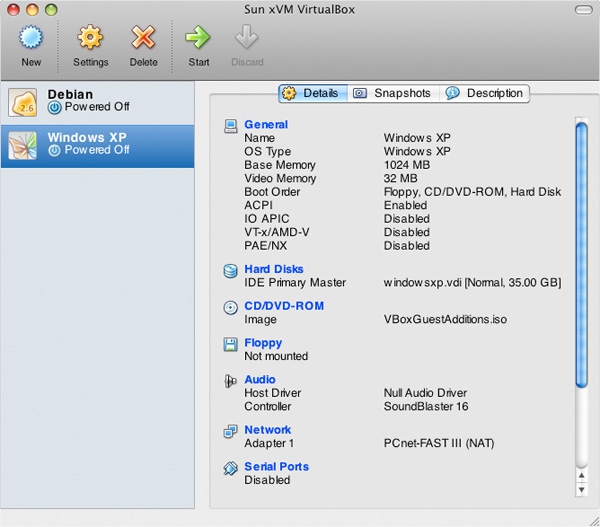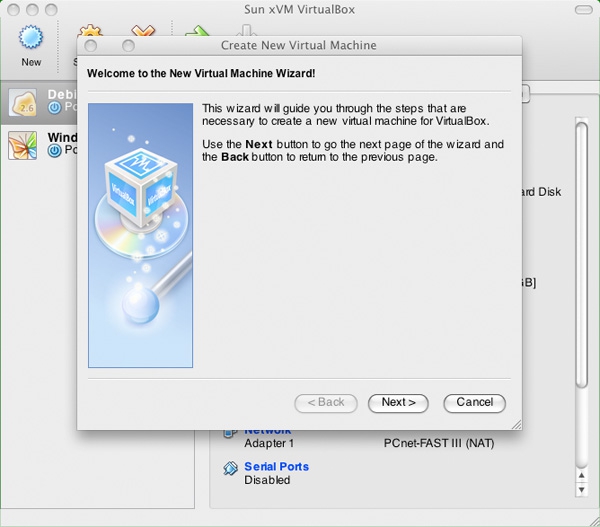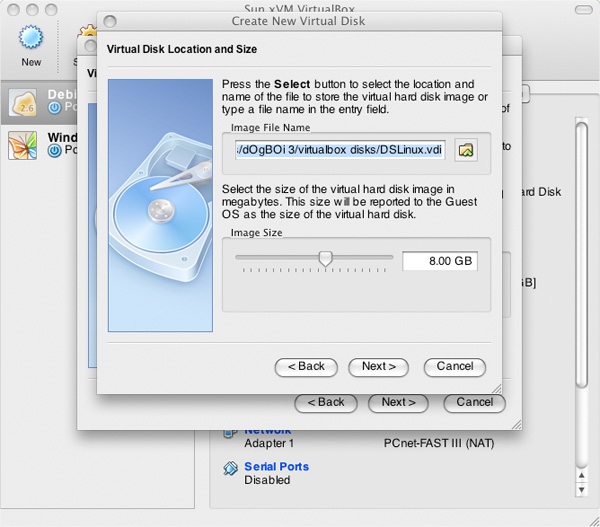 VirtualBox: A Free Virtual Machine For Your Mac
VirtualBox: A Free Virtual Machine For Your Mac

Product Category: Virtual Machine Software
Developer: Sun Microsystems, Inc.
Where to Buy: VirtualBox Home Page
Price: Free
System Requirements: Intel based Mac
Specifications: Requires 70 Megabytes for install, plus space for virtual disk drives. Works best with higher memory configurations.
Pros: - It's free;
- Very fast performance.
Cons: - Can be hard to configure;
- No equivalent to Parallels Coherence mode;
- Doesn't work with Boot Camp Partitions.
Summary:
VirtualBox is a free alternative to VMware Fusion or Parallels. It offers excellent performance, and allows you to run Windows or Linux on your Mac alongside OS X. It's not always the most intuitive software, however.
Fast and Free

Figure 1: VirtualBox showing its Installation Wizard. I've been using VirtualBox since the Beta came out for the Mac a few months back. At that time, there were no guest additions for the Mac, so it wasn't very usable (I couldn't transfer files back and forth, for example). It's recently been updated, and is no longer Beta. I use it to run Linux on my Mac alongside OS X. What initially attracted me to VirtualBox was the price. It's free, as opposed to $79.95 for Parallels or VMware Fusion. My needs are modest; I only need to be able to run Linux and Windows and don't need an equivalent to Parallels Coherence or Fusion's Unity. If you do need that functionality, then VirtualBox probably isn't for you. VirtualBox runs exceptionally fast. In my testing with Linux and Windows, it's been significantly faster than Parallels or VMware Fusion, and it doesn't use as many system resources as either. That being said, it's not as easy or as intuitive as either of them, and it doesn't support Boot Camp partitions. Setting up a Virtual Machine 
Figure 2: Creating a Virtual Disk Drive is simple in VirtualBox. The initial setup of a Virtual Machine is fairly easy. You just press the New button and follow the on-screen prompts. You'll have to create a virtual disk (which is true of any Virtual machine software). Once everything is set up, just insert a disc or mount an ISO image and it will install. It's after the install that you might notice some problems. For example, in my testing, Windows sound didn't work out of the box. I had to reconfigure VirtualBox's sound settings to turn it on. You can't change most of the settings unless the Virtual Machine is off. So I had to shut it off, change the settings, reboot and test. I had to do this several times before I found the right settings to make things work correctly. Once it's configured, though, it works without problems. For example, the correct sound configuration for a Windows guest on my MacBook was setting "Host Audio Driver" to CoreAudio and "Audio Controller" to ICH AC97.
Guest Additions 
Figure 3: Windows XP running in VirtualBox. The Guest Additions installed without any problems in both Linux and Windows. I did have to install the Linux headers using Debian's "apt-get" command, but I had to do that with VMware as well, since the guest additions to any Virtual machine need to be compiled against the Linux kernel. The Guest Additions allow you to share folders between your Mac and the Virtual Machine. They also add tighter integration between the guest and host OS, especially with regards to the mouse. Shared folders show up on the network. You can set folders up temporarily, or set them up to be shared every time the virtual machine is loaded. In windows, I usually map a driver letter to each shared folder so they're easier to find. Conclusion
If you don't need Coherence/Unity and you don't need to access a Boot Camp partition, VirtualBox is a viable solution for any Mac user to occasionally run Linux or Windows on your Mac. While it can sometimes be less than intuitive, once it's set up, it runs flawlessly. It's fast and efficient and runs Linux and Windows well. In short, it's certainly worth more than its Free price tag would suggest. Joe Johaneman is a programmer and web designer in Honesdale, PA. He is also an amateur photographer and graphic designer.
__________________
iMac 21.5 inch, Macbook 13 inch, 32GB iPhone 4, 8GB 1st gen iPod Touch, 64GB iPad WiFi, AppleTV, iPod Shuffle
|